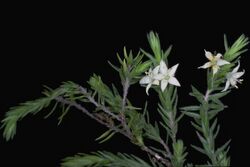Biology:Epacris gnidioides
| Epacris gnidioides | |
|---|---|

| |
| Scientific classification | |
| Kingdom: | Plantae |
| Clade: | Tracheophytes |
| Clade: | Angiosperms |
| Clade: | Eudicots |
| Clade: | Asterids |
| Order: | Ericales |
| Family: | Ericaceae |
| Genus: | Epacris |
| Species: | E. gnidioides
|
| Binomial name | |
| Epacris gnidioides (Summerh.) E.A.Br.[1]
| |
| Synonyms[1] | |
| |
Epacris gnidioides, commonly known as Budawangs cliff-heath,[2] is a species of flowering plant in the heath family Ericaceae and is endemic to a restricted area of New South Wales. It is a small, creeping shrub with hairy branches, sharply-pointed lance-shaped leaves, and tube-shaped, white flowers.
Description
Epacris gnidioides is a creeping, rhizome-forming shrub with branches up to 50 cm (20 in) long. Its leaves are lance-shaped, 4–8 mm (0.16–0.31 in) long and 1–2 mm (0.039–0.079 in) wide on a petiole about 1.5 mm (0.059 in) long. The leaves are thin, concave and covered with long, soft hairs. The flowers are arranged singly in leaf axils on a pedicel 1.5–5 mm (0.059–0.197 in) long, the sepals 2.5–3.0 mm (0.098–0.118 in) long. The petals are white and form a tube 1.0–1.2 mm (0.039–0.047 in) long, the lobes 3.0–3.5 mm (0.12–0.14 in) long and tapered. Flowering occurs from September to February and the fruit is a capsule about 2 mm (0.079 in) long.[3][4]
Taxonomy
This species was first formally described in 1927 by Victor Samuel Summerhayes who gave it the name Rupicola gnidioides in the Bulletin of Miscellaneous Information from specimens collected in 1927 by Frederick A. Rodway near the Ettrema River, south west of Nowra in a "cleft in sandstone cliff".[5][6] In 2015, Elizabeth Anne Brown changed the name to Epacris gnidioides in Australian Systematic Botany.[7] [8]
In 1992, Ian Telford raised the genus Budawangia and changed the name Rupicola gninioides to Budawangia gnidioides in the journal Telopea, but that name is regarded as a synonym of Epacris gnidioides by the Australian Plant Census.[4][1][9]
Distribution and habitat
Budawangs cliff-heath grows in rock crevices and on sandy ledges at the base of sandstone cliffs on the edges of forest and heath and is only known from the northern Budawang Range in south-eastern New South Wales.[2][3][10]
Conservation status
Epacris gnidioides is listed as "vulnerable" under the Australian Government Environment Protection and Biodiversity Conservation Act 1999 (EPBC) Act and the New South Wales Biodiversity Conservation Act 2016. The main threats to its survival are its narrow distribution, inappropriate fire regimes, and use of sandstone caves for camping.[2][10]
References
- ↑ 1.0 1.1 1.2 "Epacris gnidioides". Australian Plant Census. https://biodiversity.org.au/nsl/services/apc-format/display/4535425.
- ↑ 2.0 2.1 2.2 "Budawangs cliff-heath". New South Wales Government Office of Environment and Heritage. https://www.environment.nsw.gov.au/threatenedspeciesapp/profile.aspx?id=10111.
- ↑ 3.0 3.1 Powell, Jocelyn M.. "Epacris gnidioides". Royal Botanic Garden Sydney. https://plantnet.rbgsyd.nsw.gov.au/cgi-bin/NSWfl.pl?page=nswfl&lvl=sp&name=Epacris~gnidioides.
- ↑ 4.0 4.1 Telford, Ian R. H. (1992-09-30). "Budawangia and Rupicola, new and revised genera of Epacridaceae". Telopea (Sydney: National Herbarium of New South Wales) 5 (1): 231–233. doi:10.7751/telopea19924966. ISSN 0312-9764. https://www.biodiversitylibrary.org/item/264697#page/235/mode/1up.
- ↑ "Rupicola gnidioides". APNI. https://id.biodiversity.org.au/instance/apni/534283. Retrieved 24 May 2022.
- ↑ Summerhayes, Victor S. (1927). "Decades Kewenses. Plantarum Novarum in Herbario Horti Regii Conservatarum. Decas CXVIII". Bulletin of Miscellaneous Information (Royal Gardens, Kew) 1927 (8): 357. doi:10.2307/4107644.
- ↑ "Epacris gnidioides". APNI. https://id.biodiversity.org.au/instance/apni/4535930. Retrieved 24 May 2022.
- ↑ Quinn, Christopher J.; Crowden, Ronald K.; Brown, Elizabeth A.; Southam, Michael J.; Thornhill, Andrew H.; Crayn, Darren M. (2015-09-10). "A reappraisal of the generic concepts of Epacris, Rupicola and Budawangia (Ericaceae, Epacridoideae, Epacrideae) based on phylogenetic analysis of morphological and molecular data" (in en). Australian Systematic Botany 28 (1): 63–77. doi:10.1071/SB13009. ISSN 1446-5701. (DOI paywalled, proof copy at [1].)
- ↑ "Epacris gnidioides". APNI. https://id.biodiversity.org.au/instance/apni/552577. Retrieved 24 May 2022.
- ↑ 10.0 10.1 "Approved Conservation Advice for Budawangia gnidioides (Budawangs Cliff-heath)". Australian Government Department of Agriculture, Water and the Environment. https://www.environment.gov.au/biodiversity/threatened/species/pubs/55850-conservation-advice.pdf.
Wikidata ☰ Q65937558 entry
 |


